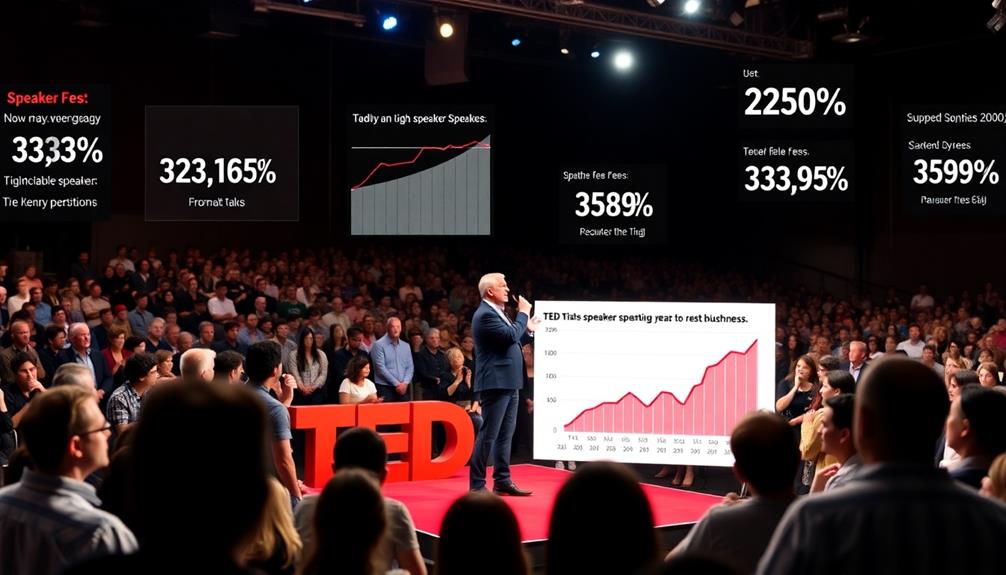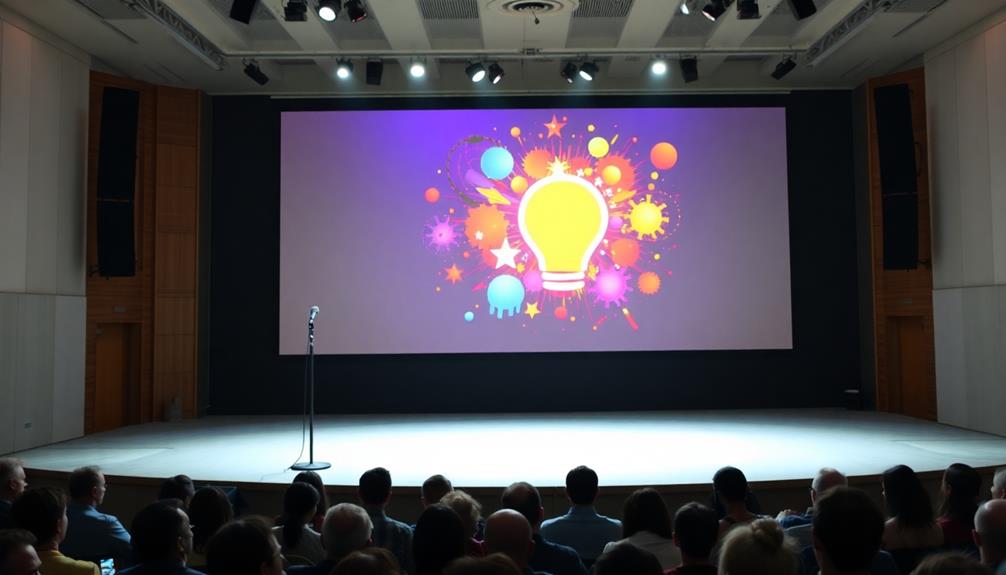Preparing for a TED talk isn't just about standing on stage. It involves over 300 hours of writing, rehearsing, and refining your delivery. You'll go through stages like research, content creation, and mental preparation. Each speaker analyzes successful talks to shape their own message. You'll craft engaging content, focusing on storytelling to connect with the audience. Rehearsals are essential, too, with practice rounds and constructive feedback to enhance your delivery. Remember to embrace nerves and use positive strategies to build confidence. There's much more to discover about this unique preparation process that can make your talk impactful.
Key Takeaways
- TED speakers spend over 300 hours on writing, rehearsing, and refining their talks, ensuring a polished delivery.
- Preparation involves four stages: research, content creation, rehearsal, and mental readiness for effective communication.
- Engaging storytelling and emotional connections are prioritized to resonate with the audience during talks.
- Speakers utilize deep breathing, visualization, and affirmations to manage anxiety and enhance focus before presentations.
- Continuous feedback from peers and TED's content team helps refine the talk for clarity and impact.
The TED Talk Experience

The TED Talk experience is a culmination of rigorous preparation. You might spend over 300 hours writing, rehearsing, and refining your delivery, aiming to perfect every aspect of your public speaking. Each rehearsal presents an opportunity to evolve your message; you may maintain multiple versions of your talk, incorporating feedback until you find the perfect balance.
As speakers refine their presentations, they often draw on insights from various fields, including advancements in Intelligent Tutoring Systems (ITS), which offer personalized learning experiences that can enhance communication skills.
On the day of your TEDx talk, nerves can creep in. To combat this, many speakers use relaxation techniques and positive mindset strategies. Deep breathing and visualization become your allies, helping you focus and enhance your performance.
The supportive TED community surrounding you fosters collaboration and idea exchange, reminding you that you're part of something bigger. Embrace every moment—you're about to share your ideas with the world.
Stages of Preparation

When you're preparing for a TED talk, you'll go through four essential stages: research, content creation, rehearsal, and mental preparation.
You'll start by analyzing successful talks to shape your own message, often utilizing powerful persuasive words to enhance your delivery.
Then, structure your content for maximum impact, ensuring that it resonates emotionally with your audience.
Research and Analysis
As you commence on the journey of preparing for a TED talk, the research and analysis stage sets the foundation for your message. This phase is vital; it's where you dive deep into understanding what makes a TED talk successful. Start by studying other talks, focusing on their structure, delivery, and even what speakers wear. Reading influential books like "Power Cues" and "How to Deliver a TED Talk" sharpens your insights into body language and speech dynamics.
Here's a quick look at essential research components:
| Research Focus | Purpose | Outcome |
|---|---|---|
| Analyze Successful Talks | Understand effective styles | Tailor your presentation style |
| Read Influential Books | Enhance presentation skills | Improve message clarity |
| Gather Feedback | Refine content through insights | Strengthen overall impact |
Engage in continuous drafting cycles and seek feedback from trusted peers. This collaborative effort allows you to test your speech, refine your content creation, and ultimately elevate your talk before the final presentation. Remember, solid research is the backbone of a compelling TED talk!
Content Structuring Techniques
Structuring your TED talk's content is like building a compelling story; it requires a clear framework that guides your audience through your message. Start with the content creation process by outlining your main message and crafting an engaging title that captures your audience's interest. This sets the stage for effective communication.
By harnessing the power of intention, you can guarantee that your talk aligns with your goals and resonates with your audience visualization techniques attract desired outcomes.
Next, focus on the structure of your talk. Begin with an engaging opening that grabs attention, then present a problem statement that resonates with your audience.
Use engaging storytelling throughout your talk; this technique not only fascinates your listeners but also makes them feel like heroes as you provide solutions to their problems.
Rehearsal and Delivery
After solidifying your content, the focus shifts to rehearsal and delivery, where the real magic happens. You'll likely engage in multiple rounds of practice, committing to rehearse several times daily in various settings. This helps refine your delivery and timing.
Effective rehearsals involve using a countdown timer to simulate real conditions and bullet point notes to guide you without relying on a full script. Recording your practice sessions is invaluable. It allows you to listen back, adjusting your delivery based on vocal strain and pacing.
Engage in high-energy rehearsals to enhance your on-stage performance and tackle the "valley of awkwardness" that often comes with initial attempts. Pay attention to your body language, as purposeful movement is essential. Step forward to emphasize key points—this not only keeps the audience engaged but also guarantees your movement supports rather than distracts from your message.
Each rehearsal is an opportunity to hone your presence, making your delivery smoother and more impactful come performance day. Embrace this stage; it's where your talk transforms from words on a page to a compelling experience for your audience.
Research Techniques

When preparing your TED talk, analyzing successful speeches can reveal key elements of effective structure and delivery.
Studying different presentation styles helps you find what resonates best with your audience.
Additionally, reading influential literature can sharpen your message and enhance your overall impact.
Analyzing Successful Talks
A speaker's success often hinges on their ability to dissect and learn from the best TED talks. You should start by analyzing successful talks, focusing on their structure and delivery.
Pay attention to how these speakers engage their audience and weave storytelling into their presentations. Watching a variety of TED and TEDx talks exposes you to diverse techniques, helping you find what resonates with your style.
Influential books like "Power Cues," "How to Deliver a TED Talk," and "Talk Like TED" offer valuable insights into effective body language and message clarity. Successful talks typically grab attention with a gripping opening, followed by a clear problem statement and a compelling narrative.
Don't overlook the importance of feedback. Reviewing reactions from trusted peers and analyzing audience responses to previous talks can guide you in refining your messages and delivery.
Studying Presentation Styles
Diving into various presentation styles can greatly boost your effectiveness as a speaker. By watching numerous TED and TEDx talks, you can gain insights into effective delivery techniques and speech structures. Pay attention to how successful speakers engage their audiences with enthralling openings, relatable stories, and concise problem statements. Analyzing these elements will help you understand what resonates with listeners.
Consider the attire of TED speakers; their choices often reflect professionalism while remaining approachable. This can influence how your audience perceives your message.
Also, studying the titles of popular TED talks can inspire you to create engaging titles that draw interest and set the tone for your presentation.
Reading influential books like "Power Cues," "How to Deliver a TED Talk," and "Talk Like TED" can further enhance your skills. These resources offer valuable insights into body language, storytelling, and message condensation.
Reading Influential Literature
Many speakers find that reading influential literature greatly enhances their preparation. Books like "Power Cues," "How to Deliver a TED Talk," and "Talk Like TED" offer invaluable insights into body language, speech structure, and message condensation. By diving into these resources, you'll grasp effective presentation styles that resonate with your audience.
Analyzing successful TED talks through the lens of literature allows you to understand what makes a presentation effective. You'll learn the importance of engaging storytelling and how to weave humor into your talks to maintain audience engagement. The key elements of message retention—like emphasizing essential words—become clear through this research.
Incorporating lessons from influential literature into your speech preparation not only refines your content but also enhances your delivery methods. This guarantees your presentation leaves a lasting impact.
Engaging with a variety of resources, including articles and books, supports your continuous improvement as a speaker. Ultimately, the more you invest in reading influential literature, the better equipped you'll be to captivate your audience during your TED talk, creating a memorable experience for everyone involved.
Crafting Compelling Content

Crafting compelling content for your TED talk starts with a clear focus on your main message. You need to outline that message and create an engaging title, as it greatly influences audience interest. Remember, engaging storytelling is vital; it allows you to connect with your audience and make them feel like heroes in their own stories.
| Key Elements | Importance |
|---|---|
| Main Message | Guides your talk and keeps it focused |
| Engaging Title | Captures attention and sets expectations |
| Storytelling | Builds connection and relatability |
Successful TED talks allocate about 11 minutes for content and 2 minutes for conclusions. Make sure to summarize your key points and include a call to action. Research popular TED talks to understand effective speech structures and delivery techniques, which can inform your own content creation process. Finally, don't overlook the importance of feedback from trusted friends. Multiple rounds of feedback can enhance clarity and effectiveness, ensuring your message resonates and inspires.
Effective Delivery Methods

Effective delivery methods can make a significant difference in how your TED talk resonates with the audience. Start strong by opening with an engaging story; it grabs attention and creates an immediate connection.
Humor can also enhance audience receptiveness, making your content not only engaging but also memorable. Using humor in your content can help to create a connection with your audience and make your message more relatable. Some of the richest comedians in the world have built their careers on the ability to connect with people through humor, using it as a powerful tool to engage and captivate audiences. By incorporating humor into your content, you can make it more impactful and leave a lasting impression on your audience.
Throughout your talk, emphasize key words to aid message retention, ensuring that your audience grasps the essential takeaways. Purposeful movement on stage, like stepping forward to highlight important points, keeps the focus on you and maintains interest.
Vary your vocal tones to avoid monotone delivery. A dynamic presentation aligns your tone with the emotional nuances of your content, making it more relatable.
These effective delivery methods won't only engage your audience but will also help them connect deeply with your message.
Mental Readiness Strategies

Preparing mentally for your TED talk is essential to ensuring you present with confidence and clarity. To achieve this, you should focus on several key mental readiness strategies. Engaging in deep breathing exercises is one effective method. Just take three to four smooth inhalations and exhalations to center yourself and alleviate panic. Additionally, embracing nervous energy can transform anxiety into motivation, making your presentation more dynamic.
Here's a quick overview of mental readiness strategies:
| Strategy | Description | Benefits |
|---|---|---|
| Mental Preparation | Use affirmations and visualization techniques. | Enhance focus and build confidence. |
| Deep Breathing Exercises | Perform three to four deep breaths. | Center yourself and reduce anxiety. |
| Self-Care | Prioritize rest and relaxation before the event. | Foster mental clarity and readiness. |
| Positive Counter-Statements | Counter insecurities with affirming thoughts. | Boost confidence and lower anxiety. |
Engaging With the Audience

After getting your mind ready, the next step is to focus on engaging with your audience. This connection can greatly enhance the impact of your talk.
Here are some effective strategies to keep them interested:
- Make Eye Contact: Connect with friendly attendees by looking them in the eye. This encourages receptiveness and builds trust.
- Use Humor: Incorporating humor into your presentation helps create a relaxed atmosphere. It makes you more relatable and keeps the audience engaged.
- Be Purposeful with Movement: Avoid monotonous pacing. Move intentionally on stage to emphasize key points, capturing the audience's attention and maintaining interest.
- Resonate with Emotions: Share relatable stories and examples that reflect your audience's interests. This fosters a sense of connection and makes your message more memorable.
Feedback and Improvement

Feedback is an essential part of refining your TED talk, and it often makes the difference between a good presentation and a great one. Engaging with trusted friends and colleagues during multiple rounds of feedback can provide you with honest critiques that enhance clarity and effectiveness. This process is important for improvement, as initial drafts typically require significant revisions.
Incorporating constructive criticism while maintaining self-trust is key to avoiding endless revisions. You want to strike a balance that allows room for growth without losing your unique voice. Feedback loops encourage you to reflect on audience engagement, fostering connections that will resonate during your talk.
Collaboration with TED's content team and fellow speakers brings invaluable insights, helping your topic and delivery evolve. Each piece of feedback serves as a stepping stone, guiding you toward a more impactful presentation.
Frequently Asked Questions
How Do TED Speakers Prepare?
TED speakers prepare by dedicating hours to refining content and delivery. They draft multiple versions, practice in various settings, and use mental techniques like visualization to boost confidence, ensuring their message resonates with the audience. This rigorous preparation process is a key part of how speakers reach the TED stage and deliver talks that leave a lasting impact. They seek feedback from peers and mentors, fine-tuning every detail to ensure clarity and emotional connection. By combining meticulous planning with authentic storytelling, these speakers create a compelling experience that inspires and informs audiences worldwide.
What Considerations Would a Presenter Make in Preparing a TED Talk?
When preparing a TED talk, you'll consider content clarity, delivery techniques, audience engagement strategies, and mental preparation. You'll seek feedback, rehearse multiple versions, and use visualization to boost confidence and focus.
How Long Are TED Talk Speakers Given to Prepare Their Speeches?
TED speakers often spend over 300 hours preparing their speeches. You'll typically see them dedicating several months to perfect their message, ensuring it's both engaging and impactful for the audience. It's a rigorous process!
Do TED Talk Speakers Use Teleprompters?
TED Talk speakers don't use teleprompters. Instead, they memorize their speeches to engage more naturally with the audience. This approach fosters connection and allows for a dynamic, spontaneous interaction that enhances their overall performance.
Conclusion
So, you think delivering a TED Talk is just about showing up and winging it? Think again! Behind those polished performances is a whirlwind of preparation, research, and a sprinkle of mental gymnastics. It's like preparing for the Olympics, but instead of a gold medal, you get a standing ovation and a million views. Who knew that genius requires so much effort? Next time you watch a TED Talk, remember: greatness isn't just a clever idea; it's a full-time job!









